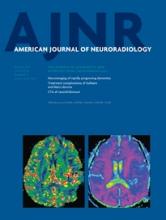Article Figures & Data
Tables
Present Absent Percentage Symptomatic cerebral hemorrhage 7 137 4.9% Air emboli 2 142 1.4% Emboli to new vascular territory 1 143 0.7% Serious groin complication 4 140 2.8% Vessel dissection 5 139 3.5% Total number of patients 18 126 12.5% Type of Intracranial Bleeding Asymptomatic (%) Symptomatic (%) Total (%) PH1 6 (4.2) 1 (0.7) 7 (4.9) PH2 5 (3.5) 1 (0.7) 6 (4.2) RIH 1 (0.7) 0 (0) 1 (0.7) IVH 5 (3.5) 1 (0.7) 6 (4.2) SAH 6 (4.2) 5 (3.5) 11 (7.6) Note:—Total number of subjects with symptomatic cerebral hemorrhage is less than the sum of individual subtype rows because some subjects had more than 1 radiologic subtype of intracranial hemorrhage. RIH indicates any intraparenchymal hemorrhage remote from the ischemic field; IVH, intraventricular hemorrhage.
Major Procedural Complications Yes, n (%) No, n (%) P Age, 22–64 y 8 (13.8%) 50 (86.2%) .80 Age, 65+ y 10 (11.6%) 76 (88.4%) Duration of symptoms <4 hours 3 (11.5%) 23 (88.5%) .68 Duration of symptoms 4–6 hours 7 (10.9%) 57 (89.1%) Duration of symptoms 6+ hours 5 (14.7%) 29 (85.3%) NIHSS score 0–10 1 (12.5%) 7 (87.5%) .81 NIHSS score 11–20 12 (12.0%) 88 (88.0%) NIHSS score >20 5 (13.9%) 31 (86.1%) IV tPA contraindicated 8 (10.5%) 68 (89.5%) .46 IV tPA failed 10 (15.2%) 56 (84.8%) Atrial fibrillation 11 (14.7%) 64 (85.3%) .46 No atrial fibrillation 7 (10.1%) 62 (89.9%) Major Procedural Complications Present n (%) P Academic centers 14 (13.9%) .59 Community centers 4 (9.3%) Roll-in patients 3 (9.7%) .76 Randomly assigned patients 15 (13.3%) Solitaire FR 10 (11.2%) .61 Merci 8 (14.5%) No rescue therapy administered 12 (11.9%) .79 Rescue therapy administered 6 (14.0%) Carotid T occlusion 5 (19.2%) .53 ICA occlusion 0 (0.0%) MCA occlusion 12 (11.5%) M1 occlusion 8 (9.5%) M2 occlusion 4 (20.0%) VB occlusion 0 (0.0%) Successful revascularization (TIMI 2–3) 7 (43.8%) .6 Unsuccessful revascularization 63 (53.4%) Note:—VB indicates vertebrobasilar.
Type of Complication MERCI % (n/N) [events] Solitaire % (n/N) [events] P SAH symptomatic 7.3% (4/55) [4] 1.1% (1/89) [1] .070 SAH asymptomatic 5.5% (3/55) [3] 3.4% (3/89) [3] .67 ICH PH1 symptomatic 1.8% (1/55) [1] 0.0% (0/89) [0] .38 ICH PH2 symptomatic 1.8% (1/55) [1] 0.0% (0/89) [0] .38 IVH symptomatic 1.8% (1/55) [1] 0.0% (0/89) [0] .38 ICH asymptomatic 27.3% (15/55) [15] 27.0% (24/89) [25] 1.00 Ischemic stroke symptomatic 12.7% (7/55) [7] 3.4% (3/89) [3] .044 All symptomatic ICH 10.9% (6/55) [6] 1.1% (1/89) [1] .013 Air emboli 1.8% (1/55) [1] 1.1% (1/89) [1] 1.00 Emboli to same vascular territory 5.5% (3/55) [3] 4.5% (4/89) [4] 1.00 Emboli to new vascular territory 1.8% (1/55) [1] 0.0% (0/89) [0] .38 Device detachment 0.0% (0/55) [0] 0.0% (0/89) [0] 1.00 Vessel dissection 1.8% (1/55) [1] 4.5% (4/89) [4] .65 Vessel vasospasm on angiography 16.4% (9/55) [10] 22.5% (20/89) [20] .40 Vessel vasospasm symptomatic 0.0% (0/55) [0] 0.0% (0/89) [0] 1.00 Major access site issues 3.6% (2/55) [2] 7.9% (7/89) [8] .48 Study device–related AE 16.4% (9/55) [13] 10.1% (9/89) [14] .31 Ancillary device–related AE 3.6% (2/55) [2] 7.9% (7/89) [8] .48 Technical difficulty with device 7.3% (4/55) [4] 10.1% (9/89) [12] .77 Note:—IVH indicates intraventricular hemorrhage; ICH, intracerebral hemorrhage; AE, adverse event.
- Table 6:
Complications of systemic (IV) thrombolysis and endovascular (intra-arterial) treatment
Trial Symptomatic ICH SAH NINDS 6.4% 0% PROACT I 15.4% na PROACT II 10.2% na IMS I 6.3% 0% IMS II 9.9% na Merci 7.8% 3.5% Multi-Merci 9.8% 9.9% Penumbra 10% 5% SWIFT-all 4.9% 7.6% SWIFT-Merci arm 10.9% 12.7% SWIFT-Solitaire arm 1.1% 4.5%












